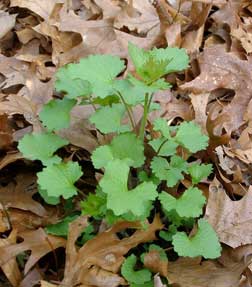Garlic mustard: Rapid invader of Michigan woodlands
Garlic mustard is rapidly becoming one of Michigan’s worst woodland weeds, threatening to displace hundreds of native woodland plants and ferns.
Editor’s note: This article is from the archives of the MSU Crop Advisory Team Alerts. Check the label of any pesticide referenced to ensure your use is included.
Garlic mustard is rapidly becoming one of Michigan’s worst woodland weeds, threatening to displace hundreds of native woodland plants and ferns. A native to Europe, it was originally introduced to North America by settlers for its proclaimed medicinal properties and use in cooking. Unfortunately, garlic mustard is on the loose and is rapidly dominating our forest floors, changing woodland habitat for plants and animals alike. It will also invade the home landscape and even take over aggressive patches of existing ground cover given the chance.

Garlic mustard. Photo credit: Rebecca Finneran
Garlic mustard is a biennial, completing its lifecycle in just two years. For the first year, garlic mustard is a diminutive, even attractive little plant with clusters of 3 to 4 rounded leaves with scalloped edges. It can easily be mistaken for a wild violet. These first-year plants remain green throughout the summer season and into the winter, making it easy to check for invasion throughout the year.
The second season, garlic mustard gets going and sends up a flower stalk in early spring resulting in tiny white flower clusters. They pollinate quickly and result in viable seeds within a few days after flowering. Second year plants can reach 20-40 inches. Seeds mature and become viable in July and August when the plant dies. At this time, unsuspecting gardeners and wood lot owners may think the plant has gone away until the thousands of seeds germinate and begin their aggressive march through the forest. In the past three to four years, I have watched this striking scene progress across miles of Michigan forests that are now completely taken over by garlic mustard.
One way humans contribute to the spread of garlic mustard is by digging and sharing their garden plants. Contaminated soil along with a coveted hosta or iris is a not-so-good gift for Aunt Millie. If you are participating in a plant exchange of some type, wash all the soil from the roots and share clean, bare root plants only.
How to control-pull, cut or chemical?
Any control method selected must be repeated for several years until the residual seeds from previous year’s plants have germinated. With a watchful eye, smaller garlic mustard infestations can be controlled by rigorous hand pulling. Plants are usually shallow rooted and pull cleanly out of a forest soil. Once plants have started to flower, whole specimens should be removed and bagged, buried or burned (with permission). Composting blooming plants is not a good option as seeds often escape the compost heating process and may not be destroyed.
You can also cut the plants before the flower buds have opened, to avoid future seed production. In other states, mowing or cutting has not proven to be the best solution. Herbicides can be used in extreme cases; however, the forest floor is a very delicate ecosystem. Severe infestations can be controlled by spraying Glyphosate in October or early spring on the green plants. This will avoid killing non-target plant material such as native plants. As always, when choosing a pesticide to control a pest, read the label carefully and apply as directed.
Help your community
If you see garlic mustard on the rise, one way you could help make a difference in your community is to organize a garlic mustard pull event. Many states have successfully kept this weed at bay in parks, zoos and neighborhoods because they have been pro-active in organizing events and making them fun. On a chilly April or May morning, sponsor coffee and donuts and provide folks with as much education as you can. For a free color, printable copy of this article, send your e-mail request to angelob@msu.edu.
Note: For more resources and training from the Kent County MSU Extension office, contact 616-336-3265 or log on to www.stuckongardening.com



 Print
Print Email
Email




